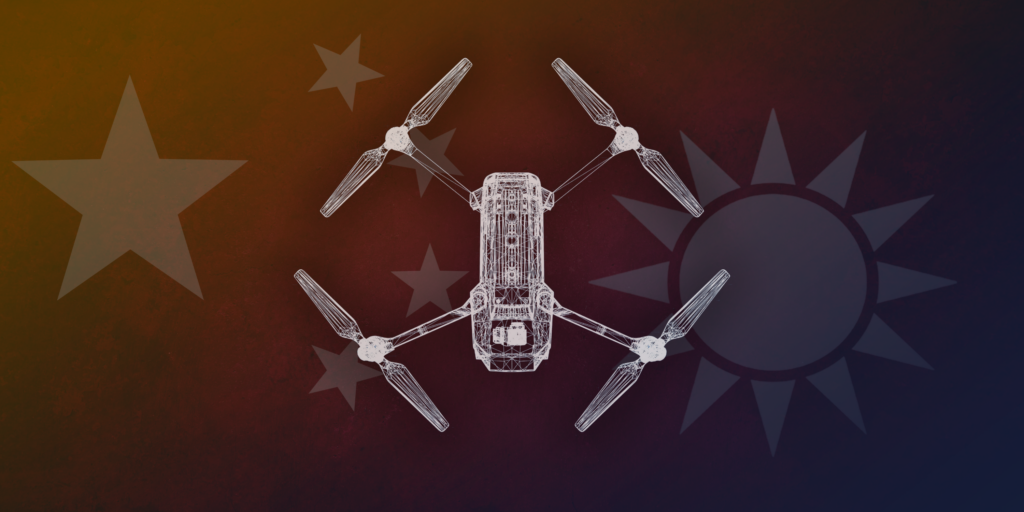As tensions escalate in the Taiwan Strait and drone warfare takes center stage in modern conflicts, Taiwan faces a critical challenge: developing a drone industry capable of countering China’s extensive and advanced unmanned systems.
Key takeaways:
-
China’s strategic investments have established it as a global leader in drone production and deployment, both militarily and commercially.
-
Taiwan is making strides in drone development but struggles with a significant capability gap, diplomatic and political constraints, and limited combat testing.
-
Expanding partnerships with countries possessing combat-tested drones, like Turkey and Israel, is critical for Taiwan to overcome its barriers and enhance its drone industry.
Growing threat
In 2020, Taiwan’s Ministry of Defense began reporting Air Defense Identification Zone (ADIZ) intrusion data. Since then, the number of incursions by China’s People’s Liberation Army (PLA) has substantially increased. These intrusions involve a variety of aircraft, including fighters, bombers, antisubmarine platforms, airborne early warning systems, reconnaissance aircraft, and signal intelligence planes. The average number of monthly incidents increased from 81 in 2021 to 178 in the first half of 2024, peaking in August 2022 with 446 sorties following US Speaker of the House Nancy Pelosi’s visit to Taipei.
China has increasingly employed drones in its ADIZ intrusions over recent years. In 2022, Chinese civilian drones flew over Taiwan’s Kinmen Island, just a few kilometers from mainland China. By 2023, PLA circumnavigation missions around Taiwan routinely included combat and intelligence, surveillance, and reconnaissance (ISR) drones, further escalating tensions in the Taiwan Strait.
The onset of the war in Ukraine was a wake-up call for Taiwan, particularly the strategic value of drones. Ukrainian drone operators have effectively slowed down Russian advances, deploying unmanned aerial vehicles (UAVs) to destroy armored vehicles, tanks, artillery units, and even air defense systems. These operations captured global attention, prompting Taiwanese policymakers to reassess the role of drones. President Tsai Ing-wen has been briefed by her national security advisor team on the necessity of incorporating UAVs into Taiwan’s defense strategy.
Despite this urgency, Taiwan’s drone capabilities remain significantly behind China’s. This gap has driven Taiwan to accelerate its efforts to develop and deploy drones as an integral part of its defense strategy.
China’s drone dominance
China recognized the tactical and strategic importance of drones in the 1990s. By 2015, projections indicated that China would produce 42,000 drones, including stealth models, within eight years. This capability allowed China to dominate the global drone market while amassing a formidable arsenal.
China’s drone industry benefits from mass production and rapid experimentation, which allow it to develop a wide range of unmanned systems, from ISR and combat drones to unmanned surface vessels (USVs). For example, the China State Shipbuilding Corporation (CSSC) recently developed the Jari USV-A, a 60-meter, 300-ton USV with vertical missile launchers and stealth characteristics. These advancements underscore China’s commitment to integrating unmanned systems into its regional power projection strategy.
In addition to meeting its military needs, China has capitalized on the global drone market by offering cost-effective, user-friendly drones to countries restricted from purchasing American drones. Chinese drones like the CH-4 are widely used in the Middle East and Africa, solidifying China’s position as the world leader in drone exports.
Taiwan’s efforts to bridge the gap
Taiwan has responded to the growing drone threat with several initiatives, though it faces significant challenges. Despite its status as a global high-tech hub, Taiwan underestimated the importance of drones in modern warfare until Ukrainian drone operators rang the bells. Before 2022, Taiwan’s drone inventory was fairly minuscule, comprising only a few hundred units across four types, compared to China’s tens of thousands of drones across 50 types.
To close this colossal gap, Taiwan launched initiatives such as forming a “Drone National Team,” establishing a drone development center in Chiayi City, and subsidizing up to 50% of research and development costs for domestic manufacturers. These efforts aim to transform Taiwan into a regional hub for drone production.
However, Taiwan’s diplomatic and political constraints hinder its drone ambitions. Unlike other countries, Taiwan cannot export weapons to active combat zones, depriving its manufacturers of operational feedback and revenue. According to data from the Stockholm International Peace Research Institute, Taiwan has engaged in significant arms exports for three decades, aside from donating decommissioned platforms to its few allies as military aid.
The experiences of other drone-producing nations illustrate Taiwan’s challenges. Effective drone development requires not only technological prowess but operational testing and feedback. Countries like Turkey and Israel have refined their drone programs through direct involvement in conflicts and exports to active combat zones. For instance, Turkey’s TB2 drones have been battle-tested in Ukraine, and Israel has improved its technology through extensive international sales.
Taiwan, however, cannot replicate these models due to its political constraints. To become “Asia’s drone industry supply chain hub among democratic nations,” Taiwan requires robust international collaboration. Existing partnerships with nations like the US, Lithuania, Poland, and Czechia have shown promise. However, given rapid advancements in China’s drone capabilities and the rising tensions in the region, Taiwan should also explore partnerships with nations that have extensive experience in combat-tested drones, such as Turkey and Israel.
Taiwan must also reassess its defense strategy to fully integrate unmanned systems. Drones are not a panacea for military challenges but serve as force multipliers within a cohesive combat framework. This strategy should include electronic warfare, interoperability between unmanned and manned systems, and the development of tactics suited to modern warfare.
The Taitronics Taiwan Expo 2024, held in October, provided a platform for Taiwanese manufacturers to showcase their capabilities, including at the dedicated “Drone Taiwan Pavilion.” (This event was a rehearsal for Taiwan’s largest aviation and defense exhibition, TADTE 2025, which will be held in September 2025.) While manufacturers presented ambitious visions for their UAVs and USVs, some projects appeared misaligned with Taiwan’s defense priorities. Balancing domestic defense needs with international market demands will be crucial for the industry’s sustainability.
Conclusion: Long road ahead
Despite its high-tech manufacturing expertise, Taiwan’s drone industry faces significant hurdles. Addressing these challenges requires a multifaceted approach: integrating drones into a coherent defense doctrine, aligning industry goals with national security priorities, and fostering international partnerships.
Taiwan’s ambition to become a hub for drone technology is significant, but achieving this vision demands sustained collaboration and strategic planning. By leveraging its strengths and learning lessons from other drone-producing countries, Taiwan can secure its place in the Asia-Pacific drone industry, bolster its security, and contribute to regional stability.






